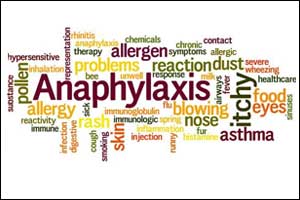- Home
- Editorial
- News
- Practice Guidelines
- Anesthesiology Guidelines
- Cancer Guidelines
- Cardiac Sciences Guidelines
- Critical Care Guidelines
- Dentistry Guidelines
- Dermatology Guidelines
- Diabetes and Endo Guidelines
- Diagnostics Guidelines
- ENT Guidelines
- Featured Practice Guidelines
- Gastroenterology Guidelines
- Geriatrics Guidelines
- Medicine Guidelines
- Nephrology Guidelines
- Neurosciences Guidelines
- Obs and Gynae Guidelines
- Ophthalmology Guidelines
- Orthopaedics Guidelines
- Paediatrics Guidelines
- Psychiatry Guidelines
- Pulmonology Guidelines
- Radiology Guidelines
- Surgery Guidelines
- Urology Guidelines
Case of anaphylactic reaction in patient allergic to mango

Dr Natalia Ukleja-Sokołowska at Department and Clinic of Allergology, Ludwik Rydygier Collegium Medicum in Bydgoszcz, Poland and associates have reported a case of anaphylactic reaction in a patient allergic to mango. The case has appeared in Journal Allergy, Asthma & Clinical Immunology.
It is said that an allergy to mango is extremely rare because the antigenic composition of the fruit is not fully known. Profilin from mango has a structure similar to birch tree profiling: it is responsible for cross-reactions between mango and pear, apple, and peach. A panallergen with a structure similar to mugwort defensin which cross-reacts with celery, carrot, peanuts, pepper, aniseed, and caraway has been previously described.
According to history a female patient, 30 years old, was admitted because of recurrent allergic reactions following the consumption of various foods. The most severe allergic reaction in the patient’s life occurred after eating a mango fruit. Within several minutes the patient developed a generalized urticaria, followed by facial oedema, strong stomach pain, and watery diarrhoea. The diagnostics involved skin tests with a set of inhalation and food allergens, including native skin tests.
The patient also experienced symptoms of recurrent, generalized urticaria in connection with consumption of various types of food, especially complex dishes containing many different ingredients.
Additionally, an interview revealed that the patient was experiencing symptoms of the oral allergy syndrome after ingesting various fruit and vegetables, especially during late summer and fall. Diagnostics was extended by determining the levels of IgE specific for allergen components, using the ImmunoCap ISAC method.
In order to confirm the occurrence of a cross-reaction between mugwort and mango allergens, the inhibition test of IgE specific for mugwort using a mango allergen extract and ImmunoCap matrix was performed.
Skin prick tests (SPT) were positive for allergens of grass 7 mm; weeds 8 mm; cat’s fur 5 mm; mugwort 6 mm. SPT were also positive for mango. The level of specific IgE was increased for allergens of mugwort, grass, celery, pepper, carrot, mango, banana, peach, and apple.
The ImmunoCap ISAC test demonstrated a high level of specific IgE rPhl p 1 (timothy grass) and Art v 1 (mugwort). We also performed the IgE inhibition test using both mango extract and ImmunoCap matrix and confirmed a cross-reaction with Art v 1 in the pathogenesis of symptoms observed in the patient.
Major takeaways from the case are:-
- An anaphylactic reaction to consumed mango, resulting from cross-allergy with mugwort Art v 1 was diagnosed in the patient.
- Acute urticarial in this case is a manifestation of IgE-mediated food allergy. During in vitro diagnostic procedures, we found an elevated concentration of IgE specific to several food allergens (including celery, peppers, carrot, banana, peach, apple, shrimp).
- The elimination diet removing allergens the patient was allergic to was recommended. Considering the anaphylactic reaction the patient was instructed to carry a rescue set composed of an adrenaline auto syringe, steroids, and antihistamines.
For more details click on the link: https://doi.org/10.1186/s13223-018-0294-1

Disclaimer: This site is primarily intended for healthcare professionals. Any content/information on this website does not replace the advice of medical and/or health professionals and should not be construed as medical/diagnostic advice/endorsement or prescription. Use of this site is subject to our terms of use, privacy policy, advertisement policy. © 2020 Minerva Medical Treatment Pvt Ltd